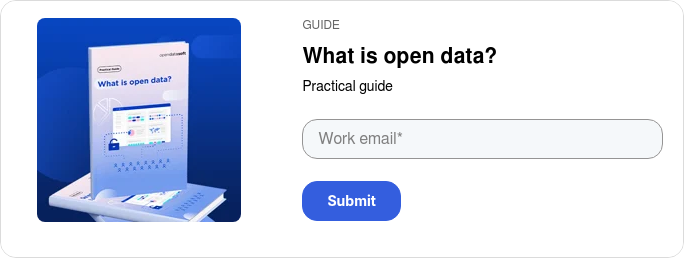2023 Open Data Maturity Report: the importance of data portals
What is the state of open data maturity across Europe? We analyze the latest EU Open Data Maturity Report to understand progress to date and where countries need to focus to increase data sharing and enable data democratization.

Making public sector information freely available, and encouraging its reuse, is essential to creating transparency and stimulating innovation. As well as being good practice such data sharing is also mandated by the Open Data Directive for European Union members, as well as by similar legislation in the USA and UK.
To measure progress towards achieving open data maturity (ODM), the European Commission therefore annually benchmarks 35 countries – a process that it has been running since 2015. The 2023 Open Data Maturity Report was published in December, and demonstrate significant progress in some areas, but a need to focus on improving data portals to drive open data sharing and reuse.
2023 Open Data Maturity Report: Assessing progress towards seamless data sharing
Run by Data.europa.eu, part of the European Commission, the Open Data Maturity Report covers 35 countries:
- 27 EU member states,
- 3 European Free Trade Association (EFTA) countries (Iceland, Norway, Switzerland),
- 5 candidate countries (Albania, Bosnia and Herzegovina, Montenegro, Serbia, Ukraine)
It assesses all countries based on four key criteria:
- Policy – the maturity of government open data policies, data governance and measures taken to implement these policies
- Impact – the willingness, preparedness and ability of countries to measure the reuse of open data and the impact created through this reuse
- Portal – the functionality of national open data portals, and how they are being tailored to meet user needs
- Quality – the processes used to ensure the highest standards of metadata and data quality for data assets on national open data portals
Based on these criteria, countries are then scored and clustered into four different groups, ranging from the most to the least mature: trend-setters, fast-trackers, followers, and beginners. This helps every country improve by providing tailored recommendations for each group, sharing best practice to encourage their development.
Key findings from the 2023 Open Data Maturity Report
Open data progress continues across EU and OECD countries
The topline findings of the report continue a positive trend towards greater maturity:
- 25 countries increased their ODM year-on-year and three countries scored the same. While seven saw a decrease in their maturity score, for six of these it was under 4%
- 77% of countries have a maturity score of 73% or higher
- EU member states improved maturity scores by an average of 4%, up to 83%
- France remains the most mature country in the EU, scoring 98.3%, ahead of Poland (97.9%) and Estonia (96.2%).
- Ukraine is the most mature candidate country, scoring an impressive 96.3%
- The biggest improvements come from Slovakia (+32%), Latvia (+23%), Montenegro (+13%) and Iceland (+12%)
The findings strongly correlate with a recent report from the Organisation for Economic Co-operation and Development (OECD), looking at open data progress across its global members. The best performing countries in the 2023 OURdata Index were Korea, France, Poland, Estonia, Spain, Ireland, Slovenia, Denmark, Sweden, and Lithuania.
The need to focus on improving open data portals
However, while overall maturity scores are increasing, the report uncovers a worrying trend around data portals – the key way that open data is shared with audiences, from citizens and businesses to public sector employees and decision-makers.
While every EU member state has a national open data portal, published machine and human readable metadata and strategies to identify and address gaps in data provision data portal maturity only grew by 2% year-on-year within the EU, compared to 6% for impact and 5% for quality.
The report comments, “The portal dimension remains the second most mature but shows the least improvement. Although the provision of data continues to improve, portal features are not becoming more sophisticated.”
Issues included a steady decrease in the ability to preview datasets, and a lack of the ability to create a dialogue with users or to rate datasets.
At a time when people increasingly want to access and reuse public sector open data, providing a seamless experience through an intuitive data portal is vital. Portal visitors, particularly non-experts, expect the same slick, user friendly experience as they’d get on an e-commerce website – failing to provide this reduces engagement and holds back data democratization.
How to improve open data portal maturity
Improving the user experience on national open data portals therefore needs to become a vital focus for countries and government departments. More sophisticated central data portals have to be developed that provide a single source of truth that enables everyone, whatever their skill level, to easily find and interact with datasets from across the public sector. That means offering a seamless experience tailored to the requirements of each and every audience, making finding the right data as simple as any other online interaction.
This requires a focus on eight areas:
1. Data visualization capabilities
Many users struggle to understand or see patterns in tabular datasets, hindering reuse. Portals therefore need to provide extensive data visualizations around datasets, such as through maps, graphics, dashboards and data stories. These bring data to life, particularly for non-experts, increasing usage and the impact of open data. Data also needs to be available for download in common formats and via APIs.
2. AI powered search
Being able to easily discover the right datasets is crucial to encouraging reuse. While all EU open data portals provide search and filtering functions, as the volume and variety of data grows this is not enough to meet changing user needs. Implementing advanced, AI-based semantic search that understands the meaning and context of a query is vital to streamlining the discovery process and increasing reuse.
3. Data lineage to track usage
While 93% of EU countries track the most/least used datasets on their portal, only 89% use analytics to drive improvements to their portal. Implementing more advanced data lineage features will enable portal owners to track exactly where datasets are being reused, providing deeper insight into user needs.
4. Preview/recommendation features for datasets
The number of portals that allow users to preview both tabular and geospatial datasets has dipped dramatically over time. While 81% of EU portals offered previews of tabular data in 2021, just 70% provided this in 2023. This makes discovering the right data more difficult and hampers confidence in reuse.
5. Promoting high-value datasets
While open data portals should be comprehensive, identifying, sharing and drawing attention to high-value datasets provides the ability to significantly benefit society in multiple ways. However, only 81% of EU countries promote high-value datasets on their portals, demonstrating a requirement to give them more prominence.
6. Enabling rating of datasets
It is difficult for data owners to know if their datasets are delivering value – or to improve them – without feedback from users. Just as on an e-commerce marketplace, users should have the ability to review and rate datasets, providing their feedback directly to data owners. However, while 82% of portals allow feedback to be added to datasets, currently just 44% of EU data portals allow users to provide ratings.
7. Show use cases to spark reuse
Reusing data is new to many people and they may struggle to understand exactly how they can use specific datasets. They therefore need support to help identify and promote reuse. To help users, 89% of EU data portals currently have a section containing use cases, while 78% allow people to share their own via the portal. This needs to be extended, as just 74% link these published reuses to specific datasets.
8. Enable requests for new datasets
Despite the comprehensive nature of national open data portals, users may want access to datasets that aren’t yet published on them. This need is growing – for example, the French and Dutch portals report that new datasets are requested on an almost daily basis. Portals therefore need to provide a simple, straightforward means to ask for these datasets, and be able to track the progress of requests transparently on the portal.
Taking the next steps in open data maturity
Across Europe, progress in open data maturity is accelerating. Not only does this encourage greater transparency and innovation, it also encourages other public and private sector organizations to open their own data and increase its usage and value. However, the 2023 Open Data Maturity Report shows the need to focus on the data portal user experience to increase usage and impact and ultimately drive greater data democratization across Europe and beyond.




